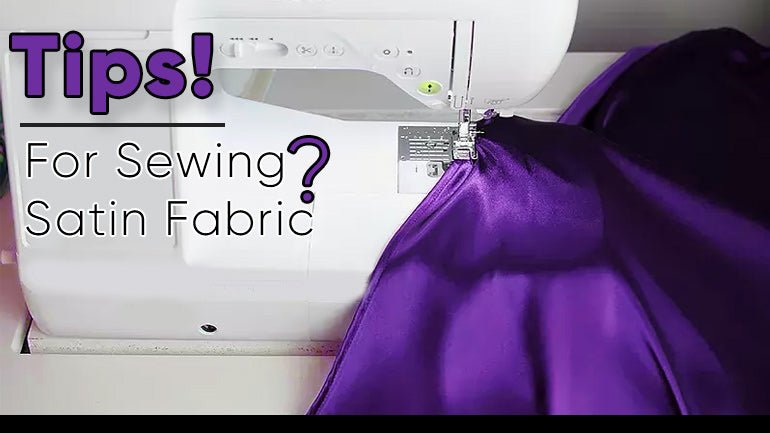Satin is a fabric that is known for its unique and shiny texture. However, it can become wrinkled over time, making it important to know Is satin safe to iron? In most cases, satin can be ironed, but it is important to be careful not to damage the fabric. Satin can wrinkle easily, and the time it takes to wrinkle depends on the type of fibers used to make it. Satin made from natural fibers, such as cotton and rayon, can be ironed, while synthetic fibers like acrylic and acetate cannot be ironed. It is important to use a low heat setting when ironing satin to avoid damaging the fabric. The article provides a step-by-step guide on how to iron satin and the specific steps to follow for ironing different types of satin garments. It also provides the best way to iron satin material.
Understanding Satin Fabric
Before we delve into the topic of ironing satin, it is essential to understand the nature of this delicate fabric. Satin is a type of weave that is characterized by a smooth, glossy surface and a dull back. It is commonly made from silk, polyester, or a blend of these materials. Satin is a popular fabric for clothing, bedding, and upholstery, as it is lightweight, breathable, and has a luxurious feel.
When it comes to washing satin, it is best to follow the care instructions on the label. Satin can be machine-washed or hand-washed, depending on the type of fabric and the manufacturer’s recommendations. However, it is important to avoid using harsh detergents, bleach, or fabric softeners, as these can damage the fabric’s delicate fibers and cause discoloration or shrinkage.
Can You Iron Satin?
Ironing satin fabric is possible, but it requires caution and attention. Satin fabric is distinct from other fabrics in that the name "satin" refers to the weaving process used to create the fabric rather than the type of fiber utilized.
Unlike cotton or polyester fabrics, which are manufactured solely from those materials, satin fabrics can be made from various fibers woven together using a satin weave. This weave imparts the fabric with its signature silky, lustrous appearance. However, the smooth texture of satin means that it is more susceptible to scorching and burning when exposed to direct heat, particularly when certain types of fibers are utilized.
Therefore, it is crucial to be mindful of the material's composition and its care requirements before attempting to iron satin. Satin fabrics produced from synthetic fibers like acetate and acrylic should not be ironed, as they are more prone to damage from melting and scorching. However, polyester satin can be ironed with caution, although it is still more susceptible to melting and scorching than natural fibers like cotton or rayon.
It is essential to use the correct iron settings when ironing satin to avoid damaging the fabric. Always check the care label to determine if the fabric can be ironed before proceeding.
Learn all there is to know about How to Sew Satin Fabric.
What Temperature to Iron Satin
The lustrous and delicate texture of satin demands extra care when it comes to ironing. To avoid scorching this unique fabric, the correct iron setting is crucial.
To achieve a perfectly pressed satin finish, opt for a low heat setting on your iron. Depending on the make and model, this can be indicated by a specific low heat setting, numbered options, or tailored settings for different fabric types.
When it comes to ironing satin, it is essential to know the right temperature to avoid damaging the fabric. Satin is a delicate material that can easily get burnt or damaged if you iron it at high temperatures.
The ideal temperature for ironing satin is a low to medium heat setting. You can set the iron temperature between 110°C to 150°C. This will help prevent the fabric from melting or becoming shiny.
Before ironing, it is recommended to use a pressing cloth or a towel between the iron and the fabric to protect the material from direct heat. Also, ensure that the iron is clean and free from any rust or debris that can stain or damage the fabric.
Can you steam iron satin? It is advisable to avoid steam as it can cause water spots or even damage the fabric. If you need to remove wrinkles, use a spray bottle filled with water and lightly spritz the fabric before ironing.
However, satin is a delicate fabric that requires a low to medium heat setting when ironing. By following the right ironing temperature and taking proper precautions, you can keep your satin looking smooth and elegant for years to come.
How to Iron Satin Fabric: Step by Step
Satin is a delicate fabric that looks beautiful when worn or used in home décor, but it can be quite tricky to iron. The wrong technique or temperature can leave behind unsightly creases, scorch marks, or even damage the fabric. However, with a little bit of practice and patience, you can easily iron the satin to perfection. Here are step-by-step instructions on how to iron satin or how to get wrinkles out of satin for various items, including dresses, shirts, tablecloths, ribbons, and more.
6 Steps for Ironing Satin Dresses:
Step 1: Read the Care Label
The first step in ironing a satin dress is to check the care label. The label will tell you the maximum temperature that the fabric can handle and whether or not it needs to be ironed with steam. Always follow the instructions on the label to avoid damaging the fabric.
Step 2: Prepare the Ironing Surface
Lay out a clean and flat ironing surface, preferably an ironing board covered with a clean cloth. Avoid using a hard surface like a table or countertop, as it can damage the fabric. If the satin dress has any embroidery or beading, turn it inside out and place a clean cloth over it to avoid damaging the embellishments.
Step 3: Set the Iron Temperature
Set your iron to the lowest temperature recommended on the care label. If you are unsure, start with a low heat setting and gradually increase it until you get the desired result. Satin is a delicate fabric that can easily scorch, so be cautious not to set the temperature too high.
Step 4: Iron the Dress
Start ironing the dress at the top and work your way down, one section at a time. Press the iron gently over each section, lift it up, and move to the next area before placing it down again. Do not slide the iron over the fabric, as it can cause the fibers to stretch or warp.
Step 5: Avoid Over-Ironing
It is essential to avoid over-ironing satin, as it can leave behind unsightly creases or marks. Pay attention to any areas that tend to crease, like the hemline or waistline, and iron them with extra care. If the satin dress has any pleats or gathers, use a cool iron to press them gently.
Step 6: Hang the Dress
Once you have ironed the satin dress, hang it on a padded hanger to avoid creasing. Do not fold it, as it can leave behind unwanted lines.
5 Steps for Ironing Satin Shirts:
Step 1: Read the Care Label
Like satin dresses, satin shirts also have care labels that provide instructions on how to iron them. Read the label and follow the instructions to avoid damaging the fabric.
Step 2: Prepare the Ironing Surface
Set up your ironing board, and cover it with a clean cloth. Turn the satin shirt inside out, and place a clean cloth over any embellishments or prints.
Step 3: Set the Iron Temperature
Set the iron to a low temperature, and make sure that the steam function is turned off. Too much steam can damage the fabric and leave water spots.
Step 4: Iron the Shirt
Start ironing the shirt from the top, one section at a time. Use gentle pressure, and move the iron in a straight line to avoid stretching the fabric. Avoid pressing too hard over seams, as it can leave behind creases.
Step 5: Hang the Shirt
Once you have finished ironing the shirt, hang it on a hanger, and allow it to cool down before wearing it.
5 steps for Ironing Table Clothes:
Step 1: Prepare your iron and ironing board
First, ensure that your iron is clean and free of any debris. Any residue on the iron can transfer onto the satin fabric, causing it to stain. Set the iron to the lowest temperature setting and turn off the steam function. It is also essential to have a clean ironing board and a clean, smooth cotton cloth to use as a protective layer when ironing the satin.
Step 2: Place the satin tablecloth on the ironing board
Carefully lay the satin tablecloth on the ironing board, making sure that it is flat and smooth. Use your hands to smooth out any wrinkles or creases.
Step 3: Use a protective layer
Place a clean, smooth cotton cloth over the satin tablecloth to protect it from the heat of the iron. This layer will prevent the iron from scorching the satin fabric.
Step 4: Iron the satin tablecloth
Starting from one corner, gently press the iron onto the protective layer and move it across the satin fabric. Avoid using a back-and-forth motion, as this can stretch and damage the fabric. Instead, lift the iron and move it to the next section. Continue this process until the entire satin tablecloth is ironed.
Step 5: Hang the satin tablecloth
Once you have ironed the entire satin tablecloth, hang it up immediately to prevent any further wrinkles from forming.
5 Steps for Ironing Ribbons:
Step 1: Prepare your iron and ironing board
As with ironing satin tablecloths, ensure that your iron is clean and free of any debris. Set the iron to the lowest temperature setting and turn off the steam function. Place a clean, smooth cotton cloth on the ironing board to use as a protective layer.
Step 2: Lay the ribbon on the protective layer
Gently lay the satin ribbon on the protective layer, making sure that it is flat and smooth. Use your hands to smooth out any wrinkles or creases.
Step 3: Cover the ribbon with a protective layer
Place another clean, smooth cotton cloth over the satin ribbon to protect it from the heat of the iron. This layer will prevent the iron from scorching the satin fabric.
Step 4: Iron the ribbon
Gently press the iron onto the protective layer and move it across the satin ribbon. Avoid using a back-and-forth motion, as this can stretch and damage the ribbon. Instead, lift the iron and move it to the next section. Continue this process until the entire ribbon is ironed.
Step 5: Hang the ribbon
Once you have ironed the satin ribbon, hang it up immediately to prevent any further wrinkles from forming.
Can you Heat-press Satin Fabric?
Satin is a luxurious fabric that is commonly used in clothing, home decor, and accessories. It has a smooth and shiny surface that adds an elegant touch to any project. Satin can be made from silk, polyester, or other synthetic fibers. One question that often arises when working with satin is whether or not it can be heat pressed.
The answer to this question is yes, satin can be heat pressed, but it requires some precautions. Satin is a delicate fabric, and applying too much heat or pressure can damage or melt it. Therefore, it is essential to follow specific guidelines when heat-pressing satin.
Here are some steps to follow when heat-pressing satin:
- Test the fabric: Before heat pressing satin, it is crucial to test the fabric's reaction to heat. Take a small piece of the satin fabric and apply heat using a low-temperature setting. Observe the fabric's response and check for any signs of melting or burning. If the fabric passes this test, you can proceed to heat-press the main fabric.
- Use the right temperature setting: Satin requires low heat when being heat pressed. Use a temperature setting of 300-325 degrees Fahrenheit to avoid damaging the fabric. It is essential to keep in mind that some types of satin fabrics may require a lower temperature setting, so check the manufacturer's instructions.
- Protect the fabric: Place a pressing cloth or a Teflon sheet on top of the satin fabric to protect it from direct heat. This layer will prevent any direct contact between the iron and the fabric, reducing the risk of damage.
- Apply even pressure: When heat-pressing satin, it is essential to apply even pressure to the fabric. Use a heat press machine or an iron to apply pressure evenly, making sure not to overdo it.
- Use a short pressing time: Heat-pressing satin requires a short pressing time to avoid overheating and damaging the fabric. It is recommended to press for no more than 15-20 seconds.
Satin can be heat pressed, but it requires specific precautions to avoid damaging the fabric. Always test the fabric, use the right temperature setting, protect the fabric, apply even pressure, and use a short pressing time. By following these steps, you can successfully heat-press satin and create stunning projects with this luxurious fabric.
Get a deeper understanding of Difference between Taffeta and Satin Fabric.
Conclusion
Ironing satin is more manageable than it may seem. With the right tools and techniques, you can safely achieve a smooth, wrinkle-free finish without damaging the delicate fabric. Always check the care label for specific instructions, use a clean and adjustable steam iron, and prepare the satin before ironing. Iron on the wrong side of the fabric, use a pressing cloth or a clean, white cotton cloth to protect it, and avoid dragging or stretching the fabric. By following above mentioned simple steps, you can enjoy your satin garments, bedding, and decor for years to come.



